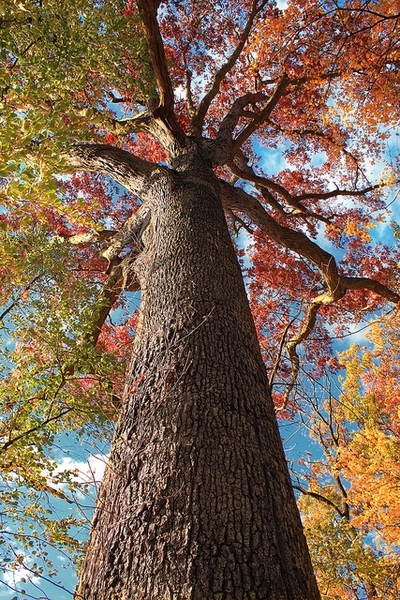The stately White Oak is one of North Carolina’s most familiar native trees, grows in a wide variety of habitats and can live as much as 600 years. White oaks support more than 500 different kinds of moths and butterflies (much more than any other native plant) and its acorns have long been staple food for a many animals, Image Credit: Nicholas-A-Tonelli-CC-BY-2.0.
This is the fourth in a series of five blogs that explore the 10,000 year history of human relationship to the land in the Piedmont region of North Carolina. Other blogs in this series include The Long Story of Catawba Run, Indigenous Cultures of the Piedmont, European Colonization, The Piedmont’s Next Chapter.
Three Hundred Years of Change
The time to gather acorns is in the fall of the year when the Piedmont forests are transformed into a blaze of color. Along with leaves of bright orange and yellow, the great white oak drops thousands of shiny copper-colored acorns ripe for the gathering. Many hands work together to collect and grind the sweet nuts into a nourishing flour with a prayer of thanksgiving that rises into the sky along with the sharp smell of ceremonial tobacco smoke.
A century later, the oak is still standing, a silent witness to the clearing along the old Indian paths to make way for the wagon roads built to bring European colonists into the Piedmont from the north. More forests fall, first to homesteads and then to make fences, barns, homes, and even furniture to be sold. The old oak still drops its acorns each fall, but soon no one gathers them.
Wagon roads turn into railways as another century passes. The magnificent oak stands tall and spreads wide as still more forests are taken to far off places on rails that bind the land to the will of the captains of industry: hot metal sparking, reeking of coal smoke, while brakes and whistles scream a prayer to progress. Four decades later railways are replaced by highways and pavement reaches right up to the trunk of the ancient oak. Even now, 300 years on, every fall the oak still drops bright orange and yellow leaves and copper-colored acorns that, instead of landing on the soft forest floor, fall on pavement and are crushed by the wheels of change.

White oaks long been an important source of food and materials for the people of the Piedmont. Acorns were a staple food of Native peoples and early European colonists. Its leaves, bark and wood – which is strong, fine-grained, and durable – has long been used by the people of the Piedmont as a source of medicines and materials for baskets, toys, tools, firewood, flooring, furniture, fence posts, shingles, barrels, and railroad ties. Credit Stanz CC-BY-SA-2.0
The story of the Piedmont is a story of how the land shaped the people and the people shaped the land. Today’s landscape is unrecognizable compared to the landscape of 300 years ago. Man-made lakes cover areas where gigantic oak, cottonwood, sycamore and ash trees measuring four to six feet in diameter once grew in rich bottomland forests. The diverse hardwood forests once typical of the region are now dominated by pines. Other unique landscapes lost to unsustainable development of the region include large areas of open grasslands within the forests, known as “Piedmont prairie”, which provided good grazing for the now extinct woodland bison.
Through wave upon wave of colonization, people of different cultures depended on the plants and animals that inhabited the region’s rolling hills, forests and waterways for food, shelter, and income for their families. The coming of the industrial age changed the relationship between land and people yet again: homesteads becoming commercial farms, plants once used for medicine were transformed into the raw materials of industry and shipped across the region, the nation, and then the globe. This rise of industry shifted and shaped the region for two centuries, forever changing the relationship between the people and the land they call home.
Between the Wars 1775 – 1860
From the revolution to the Civil War, subsistence farming was the way of life for most of the Scottish, Irish and German colonists who settled in the Piedmont. The great temperate forests offered almost everything they needed to thrive in their new home. The colonists turned forests into farmland to grow grains, vegetables, fruits and livestock and used the wood cleared from the land for building materials, heat and a source of power. They bartered with neighbors or purchased from traders the few goods they couldn’t produce themselves, growing just enough in most years to provide for their own families.
Enslaved Africans were exploited by landowners and business people throughout the Piedmont to provide unpaid skilled labor on farms, in homes and in the trades. A majority of enslaved Africans labored in agricultural fields, but planters also relied on slaves to provide their services as blacksmiths, carpenters, shoemakers, spinners, tanners, coopers, weavers, and other artisan skills. The Piedmont was not home to the large plantations common in the coastal regions of the southern colonies, but larger farms requiring additional labor beyond the family – typically 100 acres at most – were common in the region.
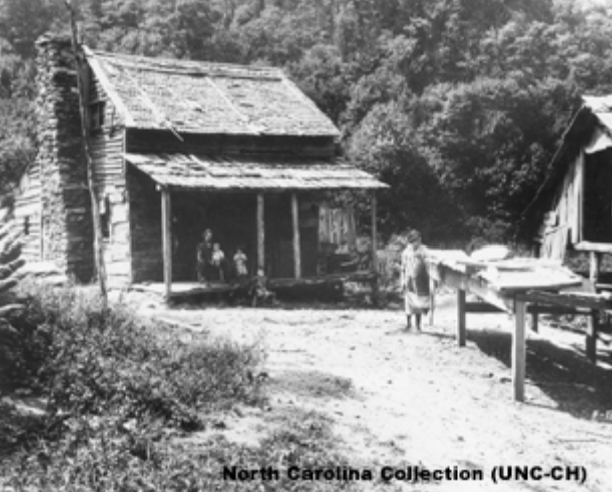
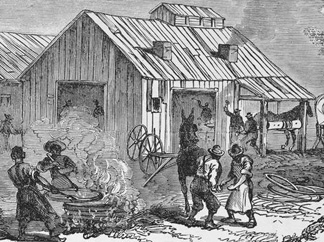
Typical Piedmont homestead (top) and African blacksmiths. Credit National Park Service.
Industrialization of the Piedmont 1865 – 1920
From Farmers to Mill Workers 1865 – 1900
After the Civil War, freed slaves and white subsistence farmers first became tenant farmers, but as industrialization picked up pace, many moved from fields to factories and rural homesteads to mill towns. In a little over 50 years, North Carolina would become the most industrialized state in the South. Tenant farmers lived on land owned by wealthy white landowners, trading “cash crops” – resources for a new and growing industry – for rent. Subsistence farmers were pushed by the declining economy off of their land and into this new way of farming. They stopped growing a variety of vegetables to feed their families and started growing the crops desired by the landowner – usually cotton or tobacco. No longer able to grow their own food, these farmers were forced to purchase food and other materials that they used to produce on their farms at high prices from local merchants.
Tenant farming arrangements of the time greatly favored the landowner so tenant families had to work as hard as they could to produce enough to pay the rent and keep themselves fed. Weighed down by poverty and debt, these families saw opportunity in the growing mill industry. Textile mills were among the most common in the region and produced blankets, sheets, and simple cloths, woven from cotton made into thread and yarn. Offering steady wages and a house near the mill, the tenant farmers and sharecroppers alike abandoned farming to follow the mill owners who visited rural areas recruiting new labor for their factories.
Making the decision to work in a mill was not just a new job, it was a completely new way of life for farmers and their families. They moved from the countryside to small towns and cities where they lived in “mill towns” or villages owned and run by the mill owners. The mill towns had houses, churches, schools, and a company store to purchase goods needed by the family. Mill workers labored long hours in hot and dusty conditions alongside loud and dangerous machinery. Black and white men, women and children all worked in the mills. White men kept the machinery in good running order and supervised women spinning yarn. Black men did the heavy labor such as lifting cotton bales and loading finished goods. Children were responsible for running the spooling machines that wove together the cotton threads into fine and coarse yards used to weave different kinds of fabrics.
Although the move from the farm to the mill town took the new millworkers out of the tobacco and cotton fields, it also helped to reconnect many with their roots as subsistence farmers. Millworkers often grew fresh vegetables like corn and potatoes, and raised hens and cows to supplement the low quality, high priced foods available at the mill town’s general store. Mill villagers brought many rural community traditions with them, including sharing the harvest with neighbors.

Mill villages like these were built to house mill workers throughout the Piedmont. Credit NCpedia.
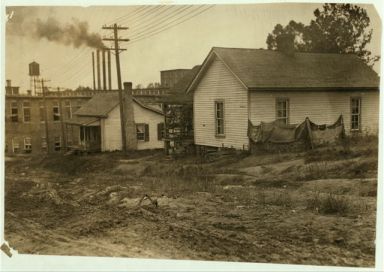
Industrial Resources of the Piedmont
As the nineteenth century dawned, railroads replaced wagon roads and expanded throughout North Carolina to become more efficient pathways for trade in the Piedmont and beyond. New railways like the Atlanta and Richmond Air-Line Railway made a direct and speedy transit between New York and New Orleans.
As industrial development picked up pace from the late 1800’s to 1920, the value of goods made in North Carolina grew from $10 million to $1 billion and the Piedmont was transformed from an agricultural to an industrial landscape. The raw materials fueling this economic transformation were known as the “three T’s”: tobacco, textiles, and timber.
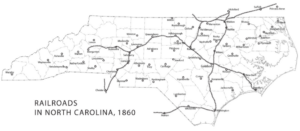
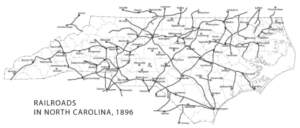
Tobacco
Tobacco became an important cash crop in the Piedmont in the mid-1800s as a result of the invention of a new kind of cured tobacco, called bright leaf, that was notably smoother and milder tobacco and a growing demand for cigarettes.
Although tobacco production depended on the labor of enslaved Africans in many regions of the U.S., tobacco was grown by white subsistence farmers on small farms in North Carolina Piedmont.
The production of high quality tobacco was very labor intensive. Everyone on the farm pitched in all through the year to make the tobacco crop. In the early spring, the tiny tobacco seeds were planted in a protected garden – called a seedbed. The seedbeds were carefully tended as the young tobacco plants large enough to be transplanted in the farm fields, which were prepared for transplanting with the help of a mule. The family stayed busy in the tobacco fields all summer, weeding, pulling worms and snapping the tops of the plants off to improve the quality of the leaves that would be harvested and taken to market in the fall. Winter months were filled with planning for next spring, buying supplies, and repairing equipment.
In the 1880s, when Washington Duke came of age, processing tobacco into cigarettes by hand was a slow and laborious process. That changed when James “Buck” Duke, Washington’s son, learned about a newly invented cigarette rolling machine. The machine was capable of producing 120,000 cigarettes per day, a volume that took 400 hours of hand rolling to match.
The rolling machine gave W. Duke, Sons and Company a substantial advantage over their competitors, and the many small factories which made cigarettes mostly by hand were replaced by a few large cigarette manufacturers in the years that followed. By 1900, cigars, chewing tobacco, and cigarettes produced in the Piedmont were sold throughout the world as the North Carolina tobacco industry grew to become the largest in the nation. Tobacco would remain the largest source of income for North Carolina agriculture for the next century and is still leads the nation in tobacco production to this day.
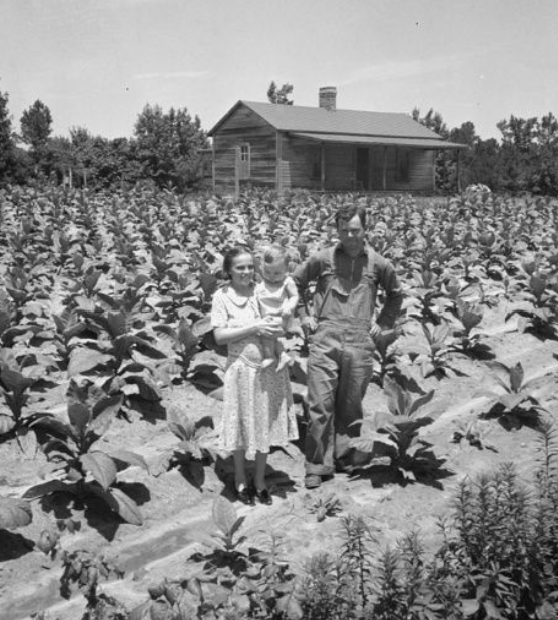
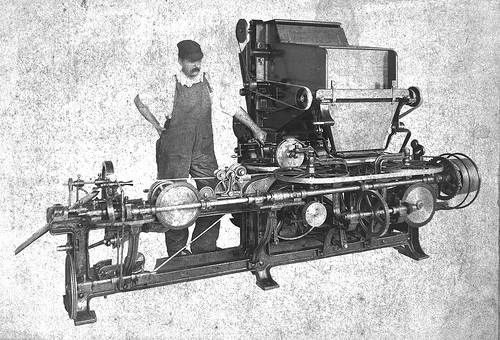
A typical tobacco farming family in the NC Piedmont circa 1940 (left) and the cigarette rolling machine (above) that transformed the NC tobacco industry. Credit NCpedia
Textiles
Various forms of fibers, yarn, cloth, and other materials used to make clothing and other cloth articles have been among North Carolina’s most important products since the early 1800’s. The state’s mild climate, accessible waterpower, wealth of raw materials in the form of cotton and lumber, and an abundance of cheap labor made the state an ideal location for a growing textile industry. Early mills produced products for use by local markets such as the coarse yarns that farm families used to make their own clothes.
Cotton was the most common fiber source for the textile industry. Although Native Americans throughout the south were growing small amounts of cotton for domestic use when the first Spanish expeditions travelled through the Piedmont in the early 1540’s, it would be 300 years before cotton began to dominate agriculture in the region.
Cotton is not an easy crop to harvest or to process for use as fiber. Until the late 1700’s, it had to be both harvested and cleaned by hand. Cleaning the seeds out of the harvested cotton was an especially laborious task requiring many hours of manual labor. However, in 1793, Eli Whitney invented the cotton gin – a machine that sped up the process of separating cotton from its seeds by a factor of ten.
Whitney’s invention drove the swift expansion of the American cotton industry over the next few decades, along with a swift increase in the number of enslaved Africans in the South. As cotton planters expanded into new lands in the Gulf Coast states and the lower Mississippi Valley, they imported enslaved Africans as agricultural laborers to increase the slave population in the south from a few hundred thousand in 1790 to more than four million by 1860. King cotton is credited with creating a clear distinction between the Southern states, where it was legal to exploit enslaved labor, and the rest of the nation, where the economy was more diversified and slave labor had been outlawed.
The growing cotton industry had little impact on the textile industry in the North Carolina, because the bulk of plantation-grown cotton was exported. The state’s textile industry continued to produce local goods from locally grown materials until the Civil War, when every mill in the state shifted to producing cloth needed for the war effort. After the war, the industry returned to producing yarn for local consumption and sold any excess to cloth manufacturers in New England. Increased demand for American-made textile goods during World War I caused a second shift to cloth production as well as a large increase in the number of textile mills in the state. This growth continued after the war, and by 1923 North Carolina led the nation in textile production.
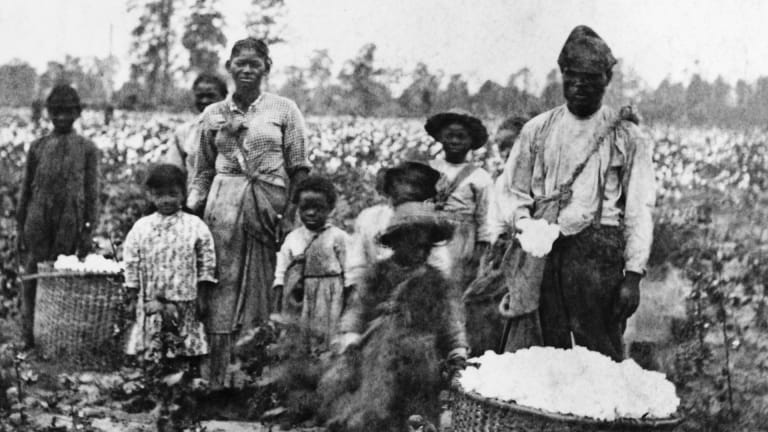
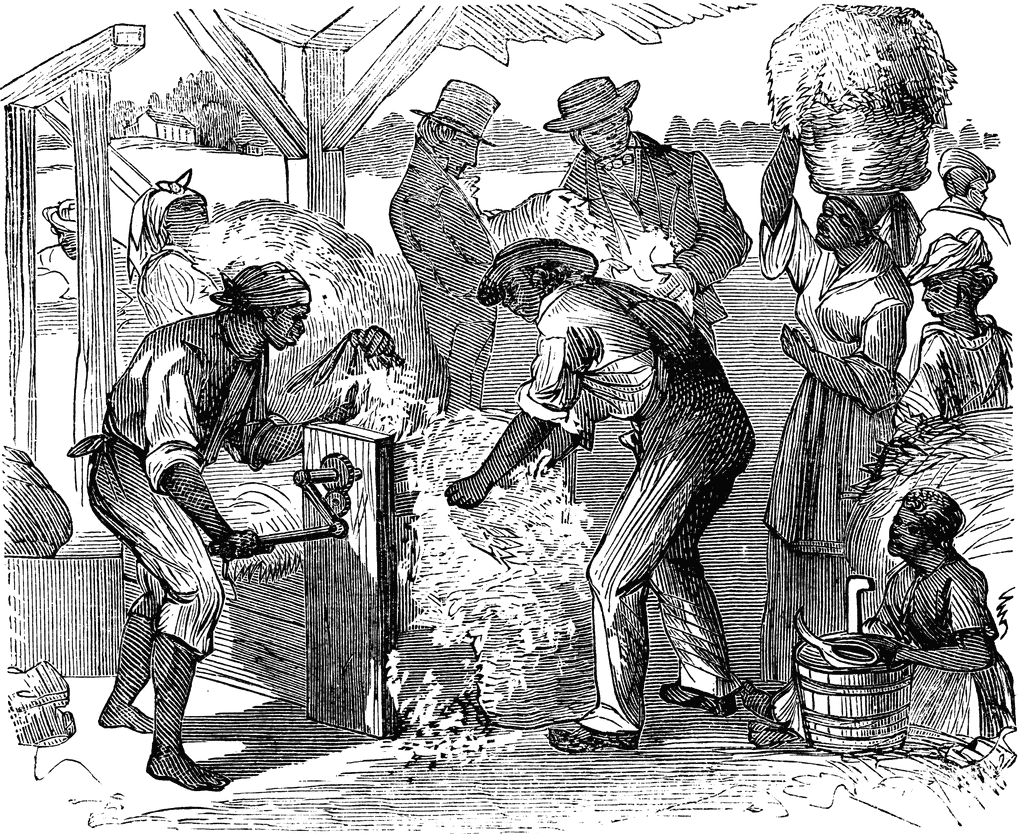
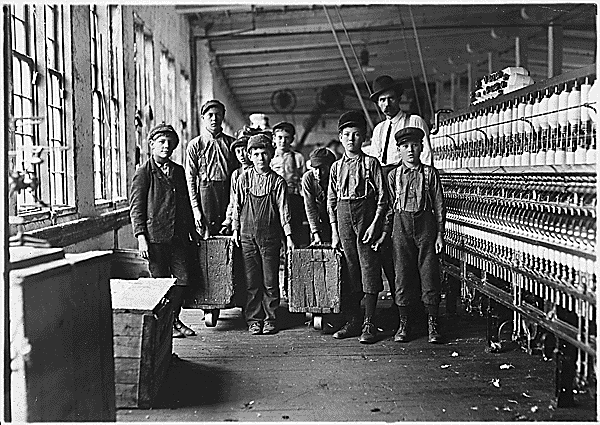
The invention of the cotton gin drove a rapid spread of slavery that came to define Southern culture. In contrast, white sharecropper and millworker families labored in cotton fields and textile mills of the Piedmont into the 20th century. Credit NCpedia
Timber
Since the earliest days of colonization in the 17th century, the great oaks and pines that dominated the seemingly endless temperate forests of the Piedmont were viewed as a rich source of raw materials for products destined for international trade. The manufacture of naval stores like pitch and turpentine from pine trees for export to England and the West Indies was important early on, but by the end of the century, timber emerged as the leading industry in the Piedmont.
Loggers worked long hours doing dangerous work cutting, hauling, and transporting oak, pine, walnut, cherry, and poplar logs to mills in rural logging towns for manufacture into consumer goods such as shingles, flooring, furniture, and cabinetry. For many rural people in the Piedmont, the dangers of working as a logger was worth the risk because logging paid better than farm work and logging work could be found close to home.
By the end of the Civil War, almost all of North Carolina’s virgin forests in the Piedmont and the Coastal Plain regions had been replaced by agriculture, unmanaged regrowth of forests that had been harvested once or sometimes twice, and growing towns and cities. The damage done by these early logging practices, especially to soil and water quality and wildlife populations, left scars on the land that we can still see today. This damage would encourage logging companies to adopt new, more sustainable forestry practices in the early 1900’s.
The North Carolina Piedmont remained associated with furniture manufacture well into the 20th century. One Piedmont town – Highpoint – would eventually claim the title “furniture capital of the world”, leading the state in the production of chairs, tables, and other home furnishings through the golden era of North Carolina’s furniture industry.
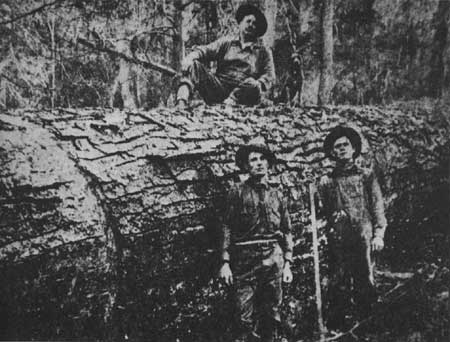
Loggers fell a white oak in the Southern Appalachian forest circa 1900. Credit National Park Service.
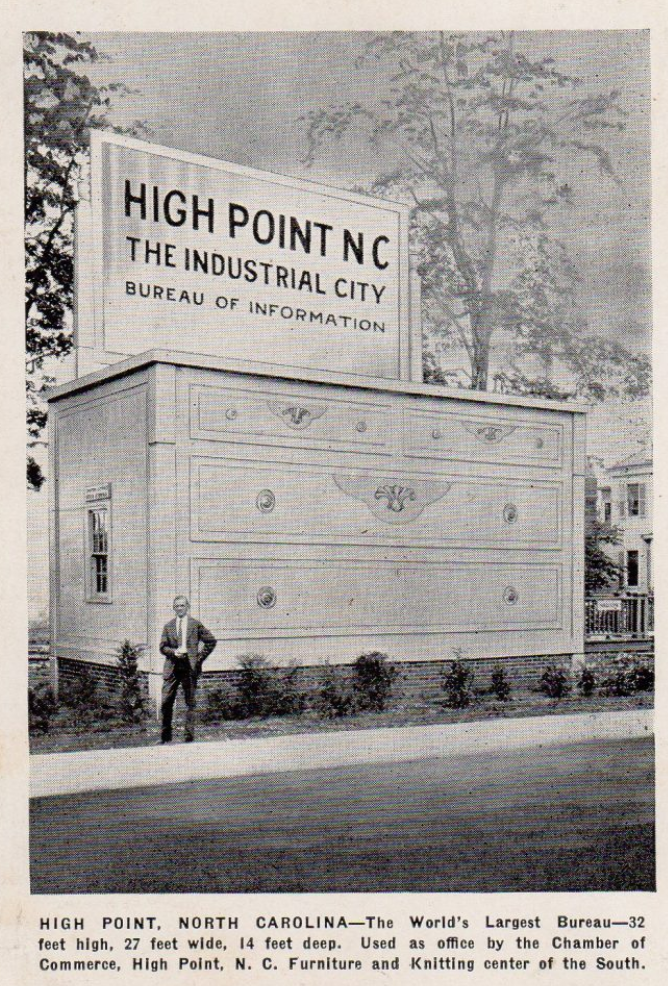
Modern Industrial Development in the Piedmont 1920 – 2000s
The growing industrial economy put pressure on North Carolina’s industries to find new sources of power and the rushing streams and rivers of the Piedmont offered a perfect solution: making electricity with running water. One of the most influential families in the state saw the potential of hydroelectric power and invested heavily in the new innovation. The Duke family’s early support of the fledgling power industry included investments in hydropower for residential and small business and street car transport services, along with natural gas and municipal water systems to serve the rapidly growing cities throughout the state. One of the early Duke hydropower projects created Lake James in the early 1920’s by building three dams on the Catawba and Linville Rivers near Morgantown in Burke County.
North Carolina continued to lead the nation in the manufacture of tobacco, timber and textile products into the late 1950s; however, the growing financial industry in the Charlotte metropolitan area and the birth of the Research Triangle were signs that the Piedmont was in the midst of yet another transformation. By the 1990s increased foreign competition challenged the industries that had sustained the Piedmont’s economy for almost a century.
As the Piedmont entered the early years of the 21st century, it became home to a vibrant new economy based on tourism, education, healthcare, finance, and technology industries. Shopping centers, restaurants, and homes have emerged from repurposed tobacco warehouses, furniture factories, mills and other historic buildings throughout the region.
Once you know where to look and what to look for, you can still see today the ways that industrialization has changed the land, the people and the communities of the Piedmont. Our present is rooted in this past and shapes the possibilities for our future, as the oak trees continue to stand witness to the changing relationships between people and the land of the Piedmont.
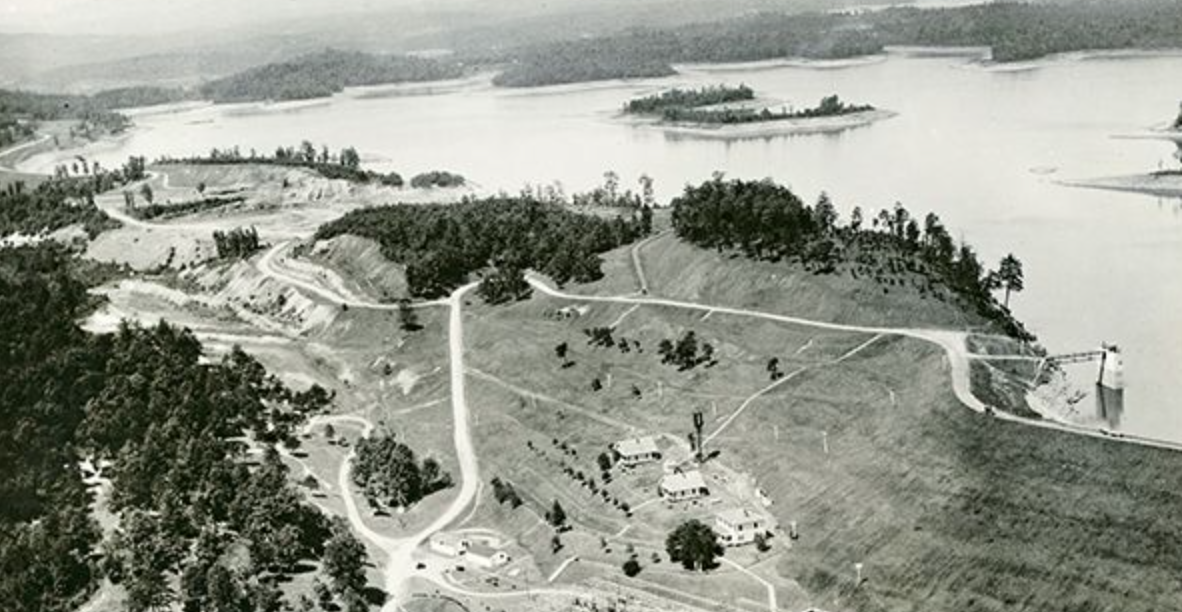
The three dams that formed Lake James under construction in 1926. Credit Duke Energy Archives.
Sources
White Oak, A North Carolina Native Tree
Life on the Land: The Mill Village and Factory
The Spread of Cotton and of Slavery 1790 to 1860
From NCpedia
Industrialization in North Carolina
The Lost Landscape of the Piedmont
The Growth of Slavery in North Carolina
1830 – 1850 Antebellum NC Begins
Catawba Run is 275 acres of old growth, unmanaged regrowth, and sustainable pine plantation located in the Piedmont region of North Carolina, near Nebo, just west of Morganton. This land is the setting for Foragable Community’s next demonstration of our shared values: to use ecological management practices and resilience principles to restore the health and wellbeing of degraded landscape, and concurrently have a positive impact on the lives of people who participate in this vision of redemption and renewal.
The Catawba Indian Nation are the descendants of the original inhabitants of land that we call Catawba Run. The Catawba, or “the people of the river” pronounced yeh is-WAH h’reh in their native tongue, were farmers, renowned potters, and stewards of the land in most of the Piedmont of South Carolina, North Carolina, and Southern Virginia. Foragable Community acknowledges that Catawba Run is on this ancestral land.

